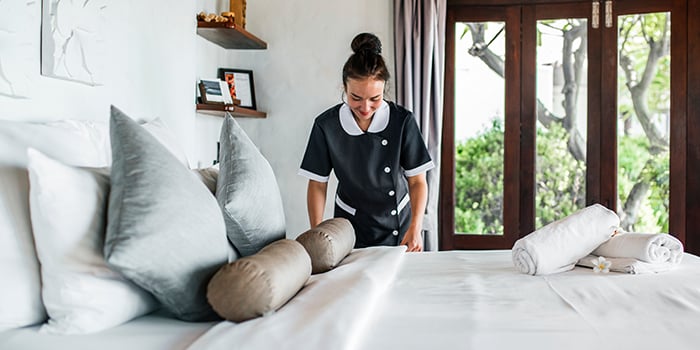
By: J. Darrel Hicks, BA, REH, CHESP | July 25, 2013
Originally published & reprinted with permission in Housekeeping Solutions on Clean Link Online
The cleaning (removing soil) and disinfection (killing bacteria and viruses) of furniture, floors and touch points is vitally important in any facility. Germs live in a moist, warm environment and making sure all surfaces are cleaned properly and frequently will minimize their spread and improve health.
In some facilities, there is confusion over who cleans what and how often. For instance, too often in hospitals, housekeeping thinks the nurses clean a surface, and nurses think those surfaces are cleaned by housekeeping. In reality, it doesn't get done. The question we need to answer is, "Who cleans this and how often is it cleaned?"
The following table is an example of necessary cleaning in a hospital to give you an idea of how often each surface or item should be cleaned and by whom:
| ITEM | FREQUENCY OF CLEANING |
WHO CLEANS? |
| Floors | Daily and spillage cleanup immediately | Housekeeping |
| Walls | Spot cleaned daily, washed annually | Housekeeping |
| Furniture | Daily and spillage cleanup immediately | Housekeeping |
| Toilet | 3 to 5 times daily depending on usage | Housekeeping |
| Sink | 3 to 5 times daily depending on usage | Housekeeping |
| Tub/Shower | Daily or as often as necessary | Housekeeping |
| Patient's Bed | The side-rails daily or as often as necessary | Housekeeping |
| Patient Care | Equipment-Between patients | Nursing Aides |

Daily cleaning of touch points
Because bacteria and viruses don't have legs, they can't walk from one room to another; they travel on dust. That is why it is so important to control dust and soil.
To reduce airborne dust and germs, wet dust horizontal surfaces daily with cleaning cloths pre-moistened with detergent or a hospital-grade disinfectant or disinfectant wipes. Use vacuums with HEPA filters and regularly clean and maintain equipment to ensure efficient particle removal.
Some great tools to battle microbes include: Steam vapor devices, which sanitize, and in some cases, disinfect without the use of chemicals; and Spray-and-vac technology, which removes, rather than kills, microbes (why kill them when you can physically remove them?).
The other way germs are spread is on people's hands. When those hands touch a door knob, a hand rail, a light switch or toilet flush handle that hasn't been cleaned and disinfected, then touch a clean surface, the cleaned surface becomes contaminated. The people spreading disease-causing germs are those who do not wash their hands properly or on a frequent basis.
At least once every 24 hours, the housekeeper's role is to clean and disinfect those contaminated surfaces in order to break the chain of infection, and thus disrupt the cycle of disease. Daily and routine cleaning and disinfecting touch points (those things that contaminated hands touch frequently) will keep the "bad bugs" away from unsuspecting building occupants and visitors.
Discharge or terminal cleaning in hospitals
Although daily cleaning and disinfection of patient's room is extremely important, the most important opportunity to break the chain of infection is the terminal cleaning of the patient's room at discharge (when they leave the hospital).
Housekeeping personnel must remove the sheets and pillow cases from the bed and pillow, being careful to not let the soiled linens contaminate your clothing or skin. Bag the soiled linen and remove it from the room. When all the patient care equipment is disinfected and removed from the room, you now have an opportunity to thoroughly clean and disinfect all the contaminated surfaces touched by the discharged patient, staff and visitors.
Besides the surfaces that might have been contaminated by soiled hands, there are cracks and crevices in the patient's bed that may have had spillage of blood, urine or feces. Since the bed is where the patient usually spends their hospital stay, it is probably very contaminated with germs, bacteria and other illnesses that are spread by contact. The entire bed needs to be thoroughly and meticulously cleaned and then disinfected, including the wheels, platform (or springs), mattress and pillow. When the bed is clean and ready, you can put clean sheets and pillowcase on according to your facility's preferred practice.

If the patient's room has a restroom, now is the opportunity to thoroughly clean it. Make sure that you start from the cleanest part of the restroom and clean toward the worst part of the room. So, start at the sink and clean, then disinfect all surfaces of the sink including the faucet handles. When the sink is clean and disinfected, then you can move on to the toilet to clean and disinfect it, too. Be sure to get under the rim and all the outside surfaces.
Washing or scrubbing a surface physically removes the soil and organic material such as blood and body fluids, and takes away with it many germs. The guiding principles is always to remove germs if possible rather than kill them, and then when necessary, use the least amount of the mildest chemical or other product that will do the job, because stronger often means more toxic to people.
Depending on your facility's policies and procedures, you need to report the clean and ready room to your supervisor or the nurse in charge so they know it is ready for the next patient.
Read More:
Ask Sadie: First Impressions & Standards of Cleanliness
FAQs About the Differences Between Disinfecting & Sanitizing
How to Reduce Hospital-Acquired Infections
The Difficulty of Keeping Restrooms Clean
Workplace Wellness: Learn What You Can Do To Stay Healthy

